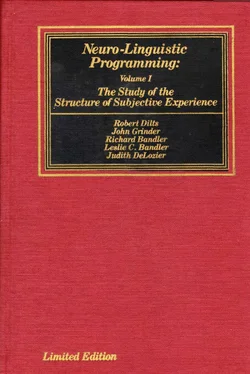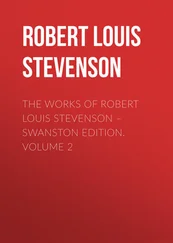Establishing an anchor requires the setting up of a synesthesia pattern. "Synesthesia," as you recall, is the correlation between representations in two different sensory systems that have become associated in time and space. As we have pointed out before, a stimulus, or representation is only "meaningful" in terms of the response it elicits in a particular individual.
Natural language is probably one of the most common, yet sophisticated, anchoring systems available to us. The written words "dog," "warmth" and "love" are all visual anchors for internal representations from the reader's past sensory experience. To make sense out of the visual symbol "dog" you have to access past experience (sights, sounds, feelings and smells) of a particular class of mammals, in the form of the 4–tuple. We can show this relationship in the following way:

T his shows that the letters "dog" anchor a particular set of representations. By changing the form of the stimulus, or by adding to it, however, we can also change the representations that are anchored. If we wrote "wet dog," or "spotted dog," for example, different representations would be anchored. Some anchors, depending on the type of anchor and the state of the individual, will not elicit representations in all sensory systems. Phrases like "look at that," "this will send shivers up your spine" or "his voice was so gravelly," each appeal to different representational systems and will anchor representations in those particular systems to a greater degree than the others.
Patterns II contains a good deal of background information on anchoring and our language systems. We suggest that you review the first few sections of the book to sharpen your understanding of the process of anchoring.
Anchors, of course, may become established through any of our sensory modalities. Facial expressions (V), gestures (V), voice tonality and tempo (A t), touches (K) and odors and tastes (O) can all be anchors for other representations. Internal sights, sounds, smells and feelings will also be anchors for other experiences. A strategy is a string of representations in which each representation is anchored to the one preceding it.
The following transcript of a typical anchoring demonstration at an NLP workshop conducted by one of the authors ("A") will illustrate the process and uses of anchoring. The volunteer will be represented as "S".
TRANSCRIPT
A: I'd like to do a demonstration of anchoring now. Would someone be willing to come and be a subject? Someone who hasn't had any experience with anchoring before? (A woman from the audience volunteers.) Your name is … ?
S: Jan.
A: Thank you, Jan. Would you sit here please … I'd like to show a couple of other things with this demonstration as well as anchoring. One of them is how to use your sensory experience to gather information and get feedback. I'm going to whisper into Jan's ear and simply ask her to think of a couple of different experiences. Then I'll anchor them. As she thinks of them, you're going to notice both subtle and perhaps dramatic changes in Jan's ongoing behavior. So I want you to tune your sensory apparatus now to watch and listen to any changes you may observe in Jan's facial expressions, breathing rate, muscle tonus, skin color, body posture and eye movements… . Okay? (Whispers in left ear.)
S: (Smiles. Eyes shift up and slightly to the right. Face flushes slightly. Breathing slightly shallow and even.) Uh-Huh … (Tonality high pitched and somewhat melodic.)
A: (Gently squeezes S's left shoulder.) Okay … good… . Now did everyone see all of the changes in Jan's face … (Agreement from the audience.) Where did her eyes go?
Man: I didn't see.
A. (turns to Jan) Jan where did your eyes go when you were thinking of that experience?
S: Huh? … Ah (eyes up) … I don't remember…
A: (Laughs) Thank you Jan, you did that so well … did everyone see that? … In order to make sense of what I'm asking she had to reaccess some of that experience and her eyes went to the same place… . How about her breathing … Where was she breathing from?
Man: I couldn't really tell. I thought it was in the chest.
A: Yes, that's correct … Did everyone hear the shift in her tonality? (Agreement from the audience.) Even though you don't know anything about the verbal content of the experience Jan was just thinking of, you have a lot of information about what might have been going on. … I want to try another one now. (Walks over to the right side of the subject and whispers in her right ear.)
S: (Eyes shift down and to the left. Face drops. Lips tightens. Clenches teeth. Sighs slightly. Skin pales. Touches face with right hand.) … Mmmhmm … (Tonality low and breathy. Volume quiet.)
A: (Squeezes S's right shoulder.) … Okay, fine … Now you can all see and hear that this is probably a very different experience from the other one, right? (Agreement from the audience.)
A: Her eyes went down and to the left this time, and her breathing changed radically … What about her tonality?
Woman: A lot lower.
A: … Skin color?
Man: Paler.
A: That's right … As we were doing this, I was attempting to anchor her two experiences kinesthetically. So I want you to pay attention as I test these two anchors … (Turns to S) Now what do you experience when I do this? (Squeezes left shoulder.)
S: (Looks back and forth from her shoulder to A's face, as if confused.) Huh? … Ummmm … Well I feel your hand on my shoulder.
A: (Laughs) Okay (Removes hand) … Is there anyone here who thinks I've succeeded in anchoring that first experience? (No response.)
A: No … That's right … What would have happened if I had anchored it successfully?
Man: She would have thought of the experience again.
A: Right … And you would have been able to see and hear the same changes in her behavior that took place before. You need to use your sensory apparatus to check and make sure anchors are solid … So … what do I do now? … A lot of people might say, "Damn, anchoring doesn't work," or … (Laughter) … "Gee, I must have done something wrong" … but the best thing that I know to do when you test and find you haven't gotten the desired response yet is to operate again … Observe … (Whispers in S's left ear.)
S: (Smiles. Face flushes. Eyes shift up. Breathing eases.) Uh-huh … (Tonality high pitched and melodic.)
A: (Squeezes S's left shoulder.) Look familiar? (Laughter.) (Agreement from audience.)
A: And then … (Walks over to right side of S and whispers in her right ear.)
S: (Lips tighten. Color pales. Eyes shift down and to the left. Sighs) … Mmmmm … (Tonality low and breathy.)
A: (Squeezes S's right shoulder) … You should all be able to recognize that one. … As you could see, I simply repeated the process again. Now, what I'm going to do is test the anchors again … (Walks over to S's left side and squeezes her left shoulder.)
S: (Smiles. Face flushes slightly. Eyes shift up. Breathing shallows.)
A: What's happening?
S: I started to think of that experience. (Tonality high pitched.)
A: And now … (Walks over to S's right side and squeezes her right shoulder.)
S: (Eyes shift down and left. Lips tighten. Skin pales. Sighs.)
A: What's going on now?
S: I'm thinking of the other one. (Voice lower and slower tempo.)
A: Okay, it seems like the anchors are working now. But I'm going to test them a couple more times to make sure … (Squeezes S's left shoulder.) S: (Smiles. Eyes up. Etc.)
Читать дальше












